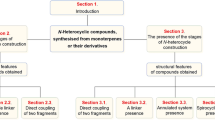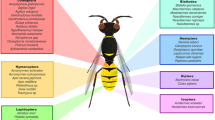Abstract
A synthesis is proposed of 4,8-dimethyldecanal (VIII) — a pheromone of the flour beetlesTribolium confusum andT. castaneum. By heating 71.2 g of 4-methyltetrahydropyran (I), 83.2 g of AcBr and 1.57 g of ZnCl2 (45°C), then 120°C, 2 h), 1-acetoxy-5-bromo-3-methylpentane (II) was obtained. The hydrolysis of 19.8 g of (II) (MeOH-H2O, TsOH, 20°C, 15 h) gave 5-bromo-3-methylpentan-1-ol (III). From 18.1 g of (III) and 38.9 ml of 2,3-dihydropyran (Et2O, TsOH, 20°C, 20 h) was obtained the 2-THPL ester of (III), (IV), which was converted into 3-methyloct-7-en-1-ol (V) by the treatment of the corresponding Grignard reagent with allyl bromide (THF, CuI-bi-2-pyridyl, 2°C, 4 h, Ar). The interaction of 1.42 g of (V) with Et3Al (hexane, 20°C, Cp2ZrCl2, Ar) gave 3,7-dimethylnonan-1-ol (VI), boiling which with 48% HBr in the presence of concentrated H2SO4 gave 1-bromo-3,7-dimethylnonane (VII) which was then converted into the desired (VIII) by the reaction of the corresponding Grignard reagent with DMFA (0–2°C, 1 h; 20°C, 2 h; Ar). The characteristics of the compounds — yield (%), nD (°C): (I), 79, 1.4340 (22); (III) 89, 1.4660 (23); (IV), 82, 1.4739 (23); (V), 85, —; (VI), 90, 1.4483 (20); (VII), 88, 1.4409 (22); (VIII), 88, 1.4589 (22). Details of the IR and PMR spectra of compounds (II)–(VII) are given.
Similar content being viewed by others
Literature cited
T. Suzuki, Agric. Biol. Chem.,45, No. 6, 1357 (1981).
T. Suzuki, Agric. Biol. Chem.,45, No. 11, 2641 (1981).
K. Mori, S. Kuwahara, and H. Ueda, Tetrahedron.,39, No. 14, 2439 (1983).
E. Breuer, J. Deutsch, and P. Lazarovici, Chem. Ind. (London), No. 22, 907 (1982).
V. N. Odinokov, V. R. Akhmetova, B. A. Cheskis, A. M. Moiseenkov, and G. A. Tolstikov, Zh. Org. Khim.,22, No. 2, 281 (1986).
U. G. Ibatullin, L. V. Syurina, S. A. Vasil'eva, and M. G. Safarov, Khim. Geterotsikl. Soedin., No. 1, 37 (1987).
R. M. Sultanov, Author's abstract of dissertation for Candidate of Chemical Sciences [in Russian], Ufa (1987).
J. Ackerman, N. Waespe-Šarčevič, and C. Tamm, Helv. Chim. Acta,67, No. 31, 254 (1984).
W. Strohmeier and F. Seifert, Chem. Ber.,94, 2356 (1961).
T. Suzuki, J. Ozaki, and R. Sugawara, Agric. Biol. Chem.,47, No. 4, 869 (1983).
Additional information
Institute of Chemistry, Bashkir Scientific Center, Urals Branch, USSR Academy of Sciences, Ufa. Translated from Khimiya Prirodnykh Soedinenii, No. 2, pp. 272–276, March–April, 1989.
Rights and permissions
About this article
Cite this article
Odinokov, V.N., Izhmuratov, G.Y., Kharisov, R.Y. et al. Pheromones of insects and their analogs. XX. Methyl-branched pheromones based on 4-methyltetrahydropyran.. Chem Nat Compd 25, 236–239 (1989). https://doi.org/10.1007/BF00598420
Received:
Revised:
Issue Date:
DOI: https://doi.org/10.1007/BF00598420




